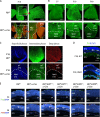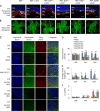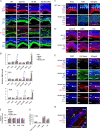Rb is required for retinal angiogenesis and lamination
- PMID: 29511172
- PMCID: PMC5840357
- DOI: 10.1038/s41419-018-0411-6
Rb is required for retinal angiogenesis and lamination
Abstract
Retinoblastoma tumor suppressor (Rb) promotes cell cycle exit, survival, differentiation, and tumor suppression in the retina. Here, we show it is also essential for vascularization and lamination. Despite minimal effects on Hif1a target expression, intraretinal vascular plexi did not form in the Rb -/- murine retina. Deleting adenovirus E2 promoter binding factor 3 (E2f3), which rescues starburst amacrine cell differentiation, or E2f2, had no effect, but deleting E2f1, which promotes neuronal cell cycle exit and survival, restored retinal vasculature. We specifically linked cell loss to the defect because removing Bax rescued rod and bipolar neurons and the vasculature, but not cell cycle exit. Despite rescuing Rb -/- neurons, Bax deletion exacerbated a delay in outer retina lamination, and exposed a requirement for Rb in inner retina lamination. The latter resembled Sem5 or FAT atypical cadherin 3 (Fat3) mutants, but expression of Sem5/Fat3 pathway components, or that of Neogenin, which perturbs migration in the Rb -/- cortex, was unchanged. Instead, lamination defects correlated with ectopic division, and were E2f1-dependent, implicating the cell cycle machinery. These in vivo studies expose new developmental roles for Rb, pinpoint aberrant E2f1 and Bax activity in neuronal death and vascular loss, and further implicate E2f1 in defective lamination. Links between Rb, angiogenesis and lamination have implications for the treatment of neovascularization, neurodegeneration and cancer.
Conflict of interest statement
The authors declare that they have no conflict of interest.
Figures






Similar articles
-
Rb-mediated neuronal differentiation through cell-cycle-independent regulation of E2f3a.PLoS Biol. 2007 Jul;5(7):e179. doi: 10.1371/journal.pbio.0050179. Epub 2007 Jul 3. PLoS Biol. 2007. PMID: 17608565 Free PMC article.
-
E2f2 induces cone photoreceptor apoptosis independent of E2f1 and E2f3.Cell Death Differ. 2013 Jul;20(7):931-40. doi: 10.1038/cdd.2013.24. Epub 2013 Apr 5. Cell Death Differ. 2013. PMID: 23558950 Free PMC article.
-
Unique requirement for Rb/E2F3 in neuronal migration: evidence for cell cycle-independent functions.Mol Cell Biol. 2007 Jul;27(13):4825-43. doi: 10.1128/MCB.02100-06. Epub 2007 Apr 23. Mol Cell Biol. 2007. PMID: 17452454 Free PMC article.
-
The RB protein family in retinal development and retinoblastoma: new insights from new mouse models.Dev Neurosci. 2004;26(5-6):417-34. doi: 10.1159/000082284. Dev Neurosci. 2004. PMID: 15855771 Review.
-
RB, the conductor that orchestrates life, death and differentiation.Oncogene. 2006 Aug 28;25(38):5210-9. doi: 10.1038/sj.onc.1209612. Oncogene. 2006. PMID: 16936739 Review.
Cited by
-
Cell cycle duration determines oncogenic transformation capacity.Nature. 2025 May;641(8065):1309-1318. doi: 10.1038/s41586-025-08935-x. Epub 2025 Apr 30. Nature. 2025. PMID: 40307557 Free PMC article.
-
Hyperglycemia-independent neonatal streptozotocin-induced retinopathy (NSIR) in rats.Front Pharmacol. 2024 Jul 23;15:1395887. doi: 10.3389/fphar.2024.1395887. eCollection 2024. Front Pharmacol. 2024. PMID: 39108749 Free PMC article.
-
Role of RB1 in human embryonic stem cell-derived retinal organoids.Dev Biol. 2020 Jun 15;462(2):197-207. doi: 10.1016/j.ydbio.2020.03.011. Epub 2020 Mar 19. Dev Biol. 2020. PMID: 32197890 Free PMC article.
-
Rb1/Rbl1/Vhl loss induces mouse subretinal angiomatous proliferation and hemangioblastoma.JCI Insight. 2019 Nov 14;4(22):e127889. doi: 10.1172/jci.insight.127889. JCI Insight. 2019. PMID: 31613797 Free PMC article.
-
Mapping transgene insertion sites reveals the α-Cre transgene expression in both developing retina and olfactory neurons.Commun Biol. 2022 May 3;5(1):411. doi: 10.1038/s42003-022-03379-9. Commun Biol. 2022. PMID: 35505181 Free PMC article.
References
Publication types
MeSH terms
Substances
Grants and funding
LinkOut - more resources
Full Text Sources
Other Literature Sources
Molecular Biology Databases
Research Materials

